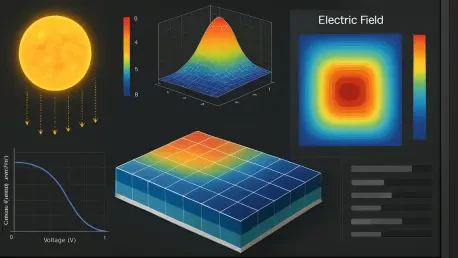In the rapidly evolving field of renewable energy, the quest for more efficient and accurate tools to model solar cell performance has never been more critical, especially as global demand for sustainable power sources continues to surge, driving researchers and engineers to seek innovative solutions. They are constantly pushing the boundaries of what solar cells can achieve. Enter Soley, a groundbreaking open-access simulation software developed at the Polytechnic University of Catalonia in Spain. This tool promises to transform the landscape of solar cell modeling by offering a fresh thermodynamic perspective that diverges from traditional methods. With its unique approach, Soley aims to complement existing platforms, providing researchers with enhanced capabilities to simulate optical and electrical performance under diverse conditions. The potential impact of this software raises an intriguing question: could it redefine how the industry approaches photovoltaic research and development?
A New Approach to Photovoltaic Modeling
Soley distinguishes itself in the crowded field of solar cell simulation by adopting a thermodynamic framework, a notable shift from the conventional drift-diffusion models that dominate tools like the Solar Cell Capacitance Simulator. Developed by researcher Zacharie Jehl Li-Kao, this software integrates the Transfer Matrix Method with an extended detailed equilibrium model to replicate photodiode behavior under illumination with remarkable precision. What sets Soley apart is its efficiency—requiring fewer input parameters, it enables rapid calculations that are ideal for high-performance batch computations. This streamlined process minimizes the risk of converging on unrealistic values during parameter tuning, a persistent challenge in other models. By focusing on speed and accuracy, Soley offers a complementary option for researchers who need reliable simulations without the burden of extensive data input, potentially accelerating the pace of innovation in solar technology.
Beyond its technical innovations, Soley’s design prioritizes versatility, catering to a wide range of applications within photovoltaic research. It supports simulations under both direct and diffuse lighting conditions, making it a valuable asset for emerging fields like indoor photovoltaics and optical layer stack optimization. The software is particularly tailored for thin-film solar cells, though its optical algorithms include stability checks that allow for modeling thicker absorber layers and even crystalline silicon cells. While it currently lacks features like photon recycling, Soley natively accommodates multijunction architectures and includes a standalone optical engine to address limitations of traditional methods. This adaptability ensures that the tool can meet the diverse needs of modern solar cell research, from mixed-index materials to complex generation function calculations, positioning it as a forward-thinking resource in the renewable energy sector.
Accessibility and Educational Potential
One of Soley’s most compelling features is its user-friendly graphical interface, crafted to make the software accessible to a broad audience, including students, educators, and seasoned researchers. Unlike many simulation tools that require steep learning curves or specialized expertise, this platform lowers the barrier to entry, allowing novices to engage with advanced photovoltaic modeling. Users can upload example solar cell models, with current templates covering a range of materials like silicon, kesterite, perovskite, and tandem perovskite/silicon devices. Plans are in place to expand this database further, incorporating cloud-based optical data access to enhance functionality. However, for serious research, users are encouraged to input their own material data to ensure accuracy. This balance of simplicity and customization makes Soley a promising tool for both academic exploration and practical application in the field.
The educational potential of Soley cannot be overstated, as it aligns with the growing need for accessible scientific tools in renewable energy studies. By offering a platform that is intuitive yet powerful, it empowers the next generation of scientists and engineers to experiment with solar cell designs and understand complex optoelectronic principles. The software’s compatibility with multiple operating systems, including Windows, Linux, and macOS, further broadens its reach, ensuring that users from various backgrounds can leverage its capabilities. As part of ongoing development within the Micro and Nanotechnologies research group at UPC, Soley also reflects a commitment to fostering collaboration across academia and industry. Its integration into initiatives like the European COST Action Renew-PV consortium underscores its relevance in advancing inorganic chalcogenide thin-film photovoltaic innovations, highlighting its role as a bridge between research and real-world impact.
Future Horizons for Solar Simulation
Looking ahead, Soley’s ongoing development signals a promising trajectory for addressing current limitations and expanding its scope within photovoltaic modeling. While the absence of photon recycling remains a gap, the software’s creators are actively working on enhancements that could further refine its accuracy and applicability. The focus on building a more comprehensive material database and integrating cloud-based solutions suggests a future where Soley could become an even more indispensable tool for researchers tackling specialized challenges. Its ability to handle multijunction designs and adapt to various lighting scenarios already positions it as a versatile asset, but continued updates could solidify its standing as a leader in the field. The emphasis on user-driven input for precise simulations also hints at a model where customization and collaboration drive innovation in solar technology.
Reflecting on the strides made with Soley, it’s evident that significant progress has been achieved in filling a critical niche in solar cell simulation through a thermodynamic lens. The software’s blend of speed, reduced parameter dependency, and adaptability to diverse cell types offers a fresh perspective that complements existing tools. Its user-friendly design opens doors for broader engagement, while its alignment with collaborative research efforts underscores a commitment to advancing renewable energy solutions. As the photovoltaic community moves forward, the groundwork laid by Soley paves the way for future tools to build upon, encouraging a shift toward more specialized and accessible modeling platforms. The journey of this software highlights the importance of balancing innovation with practicality, setting a benchmark for how simulation technology can evolve to meet the ever-growing demands of sustainable energy research.









